---------------
---------------
---------------
---------------
|
|
"Mosques
of Al-Madinah Al-Munawarah"
|
|
Qubaa' Mosque
Qubaa' Mosque is the first mosque that was
ever built in Islam. It was designed by the hand of the Messenger of
Allah, (Muhammad, Peace be upon him), after he reached that spot on
the way to Madinah during the Hijrah (migration from Makkah), as he
intended to offer prayer there. The first stones were positioned by
Prophet Muhammad, (Peace be upon him), and the mosque was completed
by the Companions of the Prophet (Allah be pleased with them all).
After that, he favoured Saturday as the day to visit Qubaa' Mosque
and offer prayer there. He (Peace be upon him) urges us to visit
this mosque as reported in some Hadith (speech and actions of the
Prophet, Peace be upon him). One hadith says: (Who performs
ablutions in his home, comes to Qubaa� Mosque and prays in it has
the reward of 'Umrah; the minor pilgrimage). Another hadith says,
(Who leaves and comes to this mosque --- meaning Qubaa' Mosque ---
and prays in it; this is equivalent to 'Umrah).
In 998 A.H., the Ottoman Sultan, Murad,
dispatched a new minbar to the Prophet's Mosque. The white marble
minbar that had been given by the Sultan, Al-Ashraf Qaitibai (circa
888 A.H.) was moved to the Qubaa' Mosque, where it remained until
the year 1408 A.H., when (during the renovation and expansion
project that was carried out by order of the Custodian of the Two
Holy Mosques, King Fahd bin 'Abdul 'Aziz AL-Sa'ud on some of the
historic mosques of Madinah in conjunction with the Second Sa'udi
expansion of the Prophet's Mosque) it was removed to the King 'Abdul
'Aziz Library (in Madinah), where it has remained ever since for
conservation.
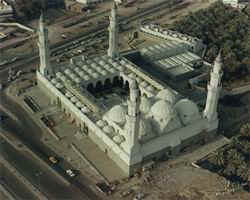
Masjid Qubaa' is very important to Muslims,
so great attention has been paid to it through the ages. It has been
restored and renovated many times, the last in the year 1405 A.H.
(1984), which adhered to its traditional Islamic architecture and
form.
The masjid is an open, colonnaded gallery on
the south and on the north, there are two galleries on the east and
west, which are separated by a large, open courtyard. The roof
itself consists of six large domes, each with a diameter of twelve
metres and fifty-six smaller domes, each with a diameter of six
metres. Massive concrete pillars inside each of the galleries
support the domes. The floor of the courtyard is covered with
heat-resistant marble, while a moveable sunshade, (that opens and
closes mechanically) made of extremely sturdy canvas, provides
protection from the elements. Towering over the masjid are four,
forty-seven metre high minarets. The main prayer area now encompasses five
thousand and fifty-six square metres, while the entire masjid
complex of buildings and accompanying secondary services, reaches
one hundred and thirty-five thousand square metres. Prior to this
most recent expansion the masjid was only twelve hundred square
metres. Attached to the masjid are an office, shopping area,
visitors services and residences for the Imam (prayer leader) and
the Mu'adthin (the one who makes the call to
prayer).
|
|
The Meeqaat Mosque
This mosque is known as the Mosque of the
Tree (or Arbor) because the Prophet (Peace be upon him),
as
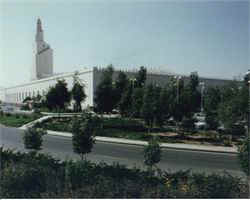
he was leaving for Makkah for
'Umrah
or Hajj, stayed under a brown shade tree in this area and prayed,
after which he began his journey. It is also called Dhul Hulaifah
Mosque (after the name of the district in which the mosque is
located). It is the meeqaat, the place of Ihram (the place where one
embarking on a journey to Makkah for 'Umrah or Hajj cannot pass
without being in a state of consecration --- intention and
cleanliness --- part of the conditions for performing 'Umrah or
Hajj), for the people of Madinah and those coming from farther
away. The mosque is situated on the west bank of
Waadi Al-'Aqeeq, approximately twenty-four kilometres from the
Prophet's Mosque.
|
|
Al-Sabaq Mosque
This mosque is located near the SAPTCo Bus Station. It has
been reported that the Prophet (Peace be upon him) entered, made
ablution and prayed in it. It is called this name (al-sabaq means
race, competition), as its location is at the field where the
Messenger of Allah (Peace be upon him) raced (trained) horses, to
prepare them for jihaad (the struggle in the Allah�s cause).
|
|
Al-Raaiyah Mosque (The
Banner)
Al-Raaiyah Mosque is located on a small
mountain called Al-Raaiyah or Mount Dthabbaab, which is close to
Mount Sila�a to its north. It has been narrated that it is called
Al-Raaiyah because a dome had been erected on it as shelter for the
Messenger of Allah (Peace be upon him) during the Battle of
Al-Ahzaab. It is also called Dthabbaab Mosque, the name of which is
ascribed to a man of Al-Yemen who came to Madinah during the
gubernatorial of Marwaan bin Al-Hukm. That man killed one official
of the governorate. His penalty was death and he was crucified on
this mountain, (but our information is scant). The important thing
is that the mosque was built during the time of �Umar bin �Abd
Al-�Aziz. It collapsed in the third century (hijrah) and the
structure was restored by the Governor, Jaanibik, in 845
A.H..
The Sa�udi Ministry of Endowments currently
maintains its old appearance and it remains one of the traditional
landmarks of Madinah. Its length reaches four metres and it has a
height of six metres, topped by a dome. |
|
Al-Fath Mosque (The Seven
Mosques)
One of the very old landmarks in Al-Madinah
Al-Munawwarah is this group of small mosques, which are situated at
the western side of Mount Sila'a. It is also at the spot of
Al-Khandaq (the Ditch, or Trench), which was dug at the time of
Prophet Muhammad (Peace be upon him), by the Muslims as a defense
for Madinah when the tribes allied with the Quraish (of Makkah)
advanced on Madinah, in the fifth year of the hijrah [626 C.E.], to
fight the Muslims. Hence, the name of the battle, Ghazwah
Al-Khandaq. The name of every mosque located therein takes its name
from the one who was posted and supervised the battle from its site.
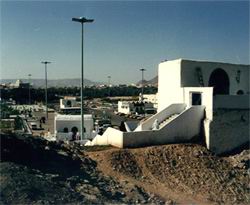
A dome was erected at the site from which
the Prophet (Peace be upon him), supervised and made surveillance of
the battle. The other mosques were subsequently erected,
consecutively from north to south. They are: Fath Mosque, Salmaan
al-Faarsi Mosque, Abi Bakr As-Siddiq Mosque, 'Umar bin al-Khattaab
Mosque, 'Ali bin Abu Taalib Mosque, and Faatimah Al-Zahraa�
Mosque.
We, do not however, have any actual
historical documentation to establish the authenticity of these
mosques, as we have pertaining to the Fath Mosque. It has been transmitted to us that �Umar bin
�Abd Al-�Aziz built the Fath Mosque, as it was either the place of
the Messenger of Allah (Peace be upon him) or it was the place in
which he supplicated to Allah for victory over the confederate
army.
|
|
Al-Qiblatain Mosque (The Mosque of the
Two Qiblah's)
Al-Qiblatain Mosque is an old mosque dating
from the time of Prophet Muhammad, (Peace be upon him). It was
originally built by Bani Salamah, who were of the Al-Khazraj tribe,
on a small hill near Waadi Al-'Aqeeq. It is five kilometres
northwest of the Prophet's Mosque.
It is called Al-Qiblatain because of the
report that some of the Companions had faced two different qiblahs
(the direction of prayer), during one prayer. The original qiblah
for Muslims was toward Jerusalem. In the second year of the hijrah,
Allah, the Almighty, revealed the verse of the Qur'an (Surah
Al-Baqarah, Verse 144) to Prophet Muhammad (Peace be upon him), to
change the qiblah to the Ka'aba at the Holy Haram (the Grand Mosque)
in Makkah. At the time of this revelation, the Messenger of Allah
(Peace be upon him), dispatched one of the Companions to convey the
newly revealed verse to the Muslims in the outskirts of the city.
The emissary arrived at the mosque of Bani Salamah, while the people
were engaged in prayer. He announced the news to them that Allah,
the Almighty, had changed the Qiblah. Upon hearing of this new
revelation while they prayed, they immediately changed the direction
of their prayer. |
|
Al-Ijaabah Mosque
Al-Ijaabah Mosque was built in the time of
the Messenger of Allah (Peace be upon him) by Banu Mu�aawiyah bin
Maalik bin �Aouf Al-Aousiyoon. At first it was called Bani
Mu�aawiyah Mosque, but then its name was changed, as the Messenger
of Allah (Peace be upon him) had prayed (two ra�akats) in it and
then asked Allah for His approval regarding certain special matters.
In the book of hadith (traditions of the
Messenger of Allah � Peace be upon him), Sahih Muslim, it states
that the Messenger of Allah (Peace be upon him) embarked one day
from Al-�Aaliyah ('Awaali) and consequently passed the Bani
Mu�aawiyah Mosque. He entered and prayed (made two ra�akats), so
(we) prayed with him. He supplicated his Lord for a long time and
came (to us). He said, �I asked my Lord three things. He gave me two
and forbid one. I asked Him that He not destroy my nation by (their)
practices; and I asked Him that He not destroy my nation by
drowning; He gave them to me. I asked him that He not make injury
between them. He denied that and that was the
drought�. |
|
Al-Ghamaamah Mosque (The Mosque of the
Cloud)
The site of this mosque is the original
location where the Prophet (Peace be upon him) used to pray Salaat
Al-�Eidain (the two �Eid prayers) and Salaat Al-Istisqaa� (the
prayer for rain). As a result it was called Al-Musalaa (the Place of
Prayer) or Musalaa Al-�Eid (the �Eid Prayer Place). It was
designated generally, as Al-Ghamaamah when it was said that here a
cloud shaded the Messenger of Allah (Peace be upon him) from the
sun.
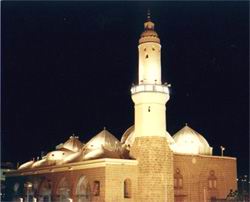
The current structure was rebuilt in the
fourteenth century by the Sultaan, �Abd Al-Hameed, the Second. The
latter portion of the same century saw a structural renovation by
the Sa�udi Ministry of Endowments, which preserved its Ottoman
design and style.
It consists of two colonnaded galleries,
which support six domes. Its length reaches twenty-six metres, its
width thirteen metres, its height twelve metres and the thickness of
its walls one and one half metres. Despite this mosque being an old
landmark of Madinah, the five daily prayers are still held in it.
|
|
Al-Jumu'ah Mosque (The Mosque of the
Friday Prayer)
This mosque is located on the banks of Wadi
Ranoonaa', approximately nine hundred metres north of Qubaa' Mosque.
It is called Al-Jumu'ah Mosque because the Messenger of Allah (Peace
be upon him), reached there at the time of the Jumu'ah (Friday)
prayer, after having stayed at Qubaa' for a number of days during
the Hijrah (migration to Madinah).
He had left Qubaa' on a Friday morning,
proceeding to Madinah and reached the place of Banu Salim bin 'Auf,
of the Ansaar (helpers) at the time the prayer was due. He, and
those with him, prayed the first Juma'ah prayer in Islam, at this
spot.
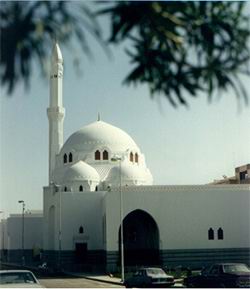
When 'Umar bin (son of) 'Abd Al-'Aziz, was
the Governor of Madinah, during the period 86 - 93 A.H. [705-711
C.E.], he erected a mosque in this place, guided by accurate
descriptions accorded to the Prophet's (Peace be upon him)
biographies. It had been renovated a number of times in the past.
Built on a small knoll, the length of the prayer area is eight
metres and its width five and one-half metres. There is also a
spacious plaza to the north, which can accommodate an overflow of
worshippers, if necessary.
The Ministry of Endowments gave
consideration to the historic location in the most recent expansion
design. The old building was razed and the knoll on which it had
stood, levelled. A new structure was erected that is larger than the
original, encompassing several additions. |
|
Al-Fadeekh (Al-Shams)
Mosque
Al-Fadeekh is the wine that is made from
dates. At the time when the Prophet (Peace be upon him) laid siege
to Bani Al-Nadeer, in the month of Rabi�e Al-Awwal in the year 4 of
the hijrah, he erected his tent near this site. Abu Ayoub and some
Sahaabah stayed not far from it and near them was Al-Fadeekh, the
wine of the date. The verse from the Qur�an descended prohibiting
alcohol, so Aba Ayoub ordered them to spill it. Thus the mosque that
was erected here became famous by this name. It is also known as
Al-Shams Mosque, perhaps for the reason that the sun rises on it
first, before the rest of the buildings in the district.
This mosque is located to the east of Qubaa�
Mosque, on the side of Waadi But�haan. Its distance from the
Prophet�s Mosque is approximately three kilometres. It is a small
mosque, square in shape and built of black basalt. In all
probability it was constructed during the time of �Umar bin �Abd
Al-�Aziz and restored in that of the Ottoman Sultaan, �Abd
Al-Majeed, the First, in 1266 A.H.. It consists of one colonnade and
courtyard; the length of the colonnade reaches about nineteen
metres, its width about fourteen. The courtyard has an area of
around one thousand four hundred metres. The edifice has five domes,
however it does not have a minaret. It is noteworthy to mention that the Prophet
(Peace be upon him) prayed in it six nights at the time of his siege
of Bani Al-Nadeer.
|
|
Al-Duraar Mosque
Al-Duraar Mosque was built by Al-Munaafiqoon (the
Hypocrites) as a place of assembly, where conspiracy spearheaded by
Abi �Aamir Al-Faasiq, was conspired and intrigued against Islam and
the Muslims. At the time that they completed its construction, the
Messenger of Allah (Peace be upon him) was intending to leave for
the Battle of Tabuk. He requested of them that he pray with them in
it, but they asked for respite until he returned from Tabuk. When
the Messenger of Allah (Peace be upon him) was returning from the
battle to arrive at Madinah, Allah revealed the reality of their
(the Hypocrites) position as regarded himself, with respect to this
mosque. He revealed the noble verse (107) from Surah (9) Al-Taubah
(The Repentance), �And as for those who put up a mosque by way of
harming and disbelief, and to disunite the believers, and as an
outpost for those who warred against Allah and His Apostle aforetime
� �. The Messenger of Allah (Peace be upon him) dispatched some of
the Companions who were ahead of him and ordered them to incinerate
it, which they did. This mosque was located near Qubaa� Mosque and
was never reconstructed after that. |
|
Abu Dthar Mosque (Al-Sajaadah � The
Prostration)
This mosque is located at the intersection of Abu Dthar
Street and Airport Road, 900 metres north of the Prophet�s Mosque.
It has been reported that the Messenger of Allah (Peace be upon him)
prayed in it and lengthened one of his prostrations to such an
extent that �Abdur Rahman bin Aouf, who had been with him, thought
that he was dead. When the Messenger of Allah (Peace be upon him)
rose, he said to �Abdur Rahman, �Indeed Jibreel informed me that he
who prays for me, Allah prays for him.�
|
|
|
|
All
the information above is taken from the web-site:
www.al-madinah.org


Links to more Madinah stories
|
|
|
|